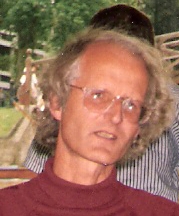Sjur Refsdal on:
[Wikipedia]
[Google]
[Amazon]
 Sjur Refsdal (30 December 1935 – 29 January 2009) was a Norwegian astrophysicist, born in
Sjur Refsdal (30 December 1935 – 29 January 2009) was a Norwegian astrophysicist, born in
 Sjur Refsdal (30 December 1935 – 29 January 2009) was a Norwegian astrophysicist, born in
Sjur Refsdal (30 December 1935 – 29 January 2009) was a Norwegian astrophysicist, born in Oslo
Oslo ( or ; ) is the capital and most populous city of Norway. It constitutes both a county and a municipality. The municipality of Oslo had a population of in 2022, while the city's greater urban area had a population of 1,064,235 in 2022 ...
. He is best known for his pioneer work on gravitational lensing
A gravitational lens is matter, such as a galaxy cluster, cluster of galaxies or a point particle, that bends light from a distant source as it travels toward an observer. The amount of gravitational lensing is described by Albert Einstein's Ge ...
, including the Chang-Refsdal lens.
Biography
In 1970 he earned adoctorate
A doctorate (from Latin ''doctor'', meaning "teacher") or doctoral degree is a postgraduate academic degree awarded by universities and some other educational institutions, derived from the ancient formalism '' licentia docendi'' ("licence to teach ...
at the Institute of Theoretical Astrophysics, University of Oslo
The University of Oslo (; ) is a public university, public research university located in Oslo, Norway. It is the List of oldest universities in continuous operation#Europe, oldest university in Norway. Originally named the Royal Frederick Univ ...
.
Later that year he became professor in astrophysics
Astrophysics is a science that employs the methods and principles of physics and chemistry in the study of astronomical objects and phenomena. As one of the founders of the discipline, James Keeler, said, astrophysics "seeks to ascertain the ...
at the Hamburg Observatory
Hamburg Observatory () is an astronomical observatory located in the Bergedorf borough of the city of Hamburg in northern Germany. It is owned and operated by the University of Hamburg, Germany since 1968, although it was founded in 1825 by the ...
in Germany
Germany, officially the Federal Republic of Germany, is a country in Central Europe. It lies between the Baltic Sea and the North Sea to the north and the Alps to the south. Its sixteen States of Germany, constituent states have a total popu ...
, and remained in that position until he retired in 2001.
In 1964 and 1966 he published a series of articles on the effects and possible applications of gravitational lenses. He is particularly known for the "Refsdal Method", which describes how one may estimate the expansion rate of the Universe (Hubble constant
Hubble's law, also known as the Hubble–Lemaître law, is the observation in physical cosmology that galaxies are moving away from Earth at speeds proportional to their distance. In other words, the farther a galaxy is from the Earth, the faste ...
) using the measured time-delay and lens properties of a gravitationally lensed Supernova
A supernova (: supernovae or supernovas) is a powerful and luminous explosion of a star. A supernova occurs during the last stellar evolution, evolutionary stages of a massive star, or when a white dwarf is triggered into runaway nuclear fusion ...
(SN).
This method was applied for the first time in 2018, with the homonymous SN Refsdal
SN Refsdal is the first detected multiply-lensed supernova, visible within the field of the galaxy cluster MACS J1149+2223. It was named after Norwegian astrophysicist Sjur Refsdal, who, in 1964, first proposed using time-delayed images from a ...
.
He later started work on stellar evolution, but returned to gravitational lensing
A gravitational lens is matter, such as a galaxy cluster, cluster of galaxies or a point particle, that bends light from a distant source as it travels toward an observer. The amount of gravitational lensing is described by Albert Einstein's Ge ...
shortly before the first detection of a gravitational lens
A gravitational lens is matter, such as a galaxy cluster, cluster of galaxies or a point particle, that bends light from a distant source as it travels toward an observer. The amount of gravitational lensing is described by Albert Einstein's Ge ...
, dubbed the Twin Quasar.
He was a member of the Norwegian Academy of Science and Emeritus
''Emeritus/Emerita'' () is an honorary title granted to someone who retires from a position of distinction, most commonly an academic faculty position, but is allowed to continue using the previous title, as in "professor emeritus".
In some c ...
at the Institute for theoretical Astrophysics at the University of Oslo
The University of Oslo (; ) is a public university, public research university located in Oslo, Norway. It is the List of oldest universities in continuous operation#Europe, oldest university in Norway. Originally named the Royal Frederick Univ ...
. On 1 February 2005 he was awarded the King's Medal of Merit
The King's Medal of Merit (Norwegian: ''Kongens fortjenstmedalje'') is a Norwegian award. It was instituted in 1908 to reward meritorious achievements in the fields of art, science, business, and public service. It is divided in two classes: gold ...
in gold.
The first detected multiply-lensed supernova
A supernova (: supernovae or supernovas) is a powerful and luminous explosion of a star. A supernova occurs during the last stellar evolution, evolutionary stages of a massive star, or when a white dwarf is triggered into runaway nuclear fusion ...
was nicknamed "SN Refsdal
SN Refsdal is the first detected multiply-lensed supernova, visible within the field of the galaxy cluster MACS J1149+2223. It was named after Norwegian astrophysicist Sjur Refsdal, who, in 1964, first proposed using time-delayed images from a ...
" in his honor.
References
{{DEFAULTSORT:Refsdal, Sjur 1935 births 2009 deaths Scientists from Oslo Norwegian astronomers 20th-century astronomers 21st-century astronomers University of Oslo alumni Norwegian expatriates in Germany Recipients of the King's Medal of Merit in gold Members of the Norwegian Academy of Science and Letters